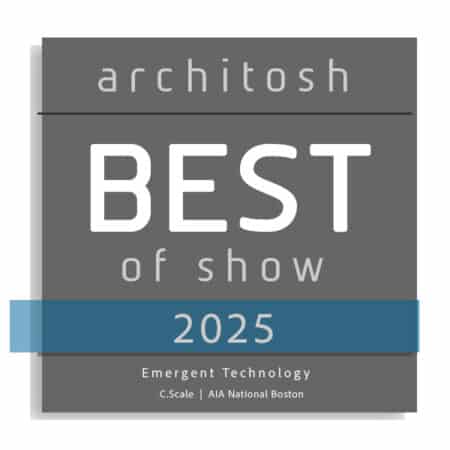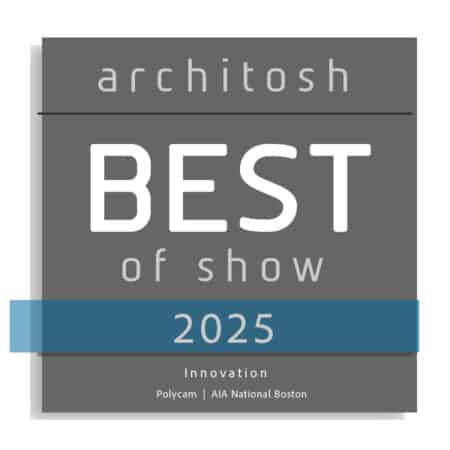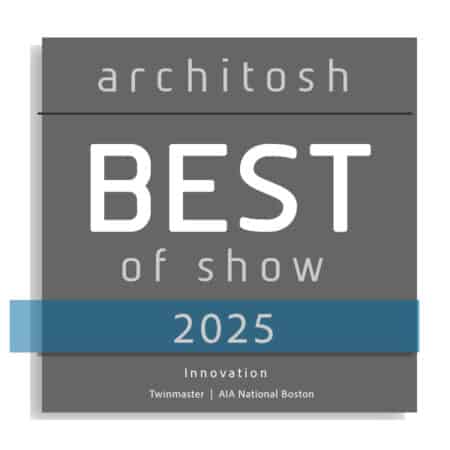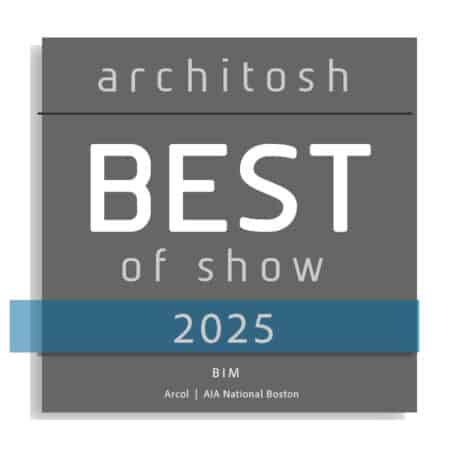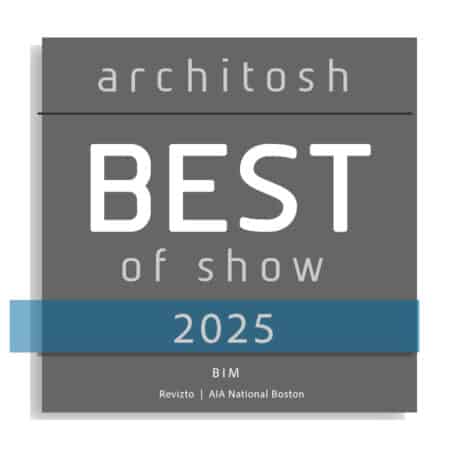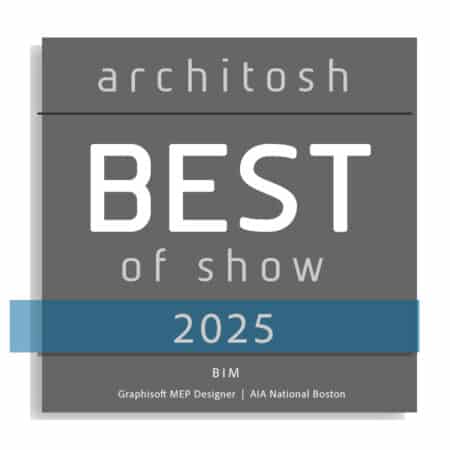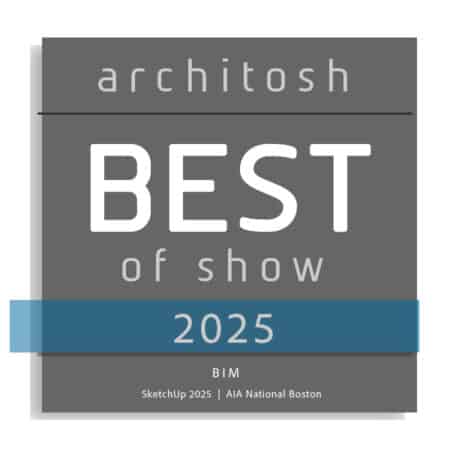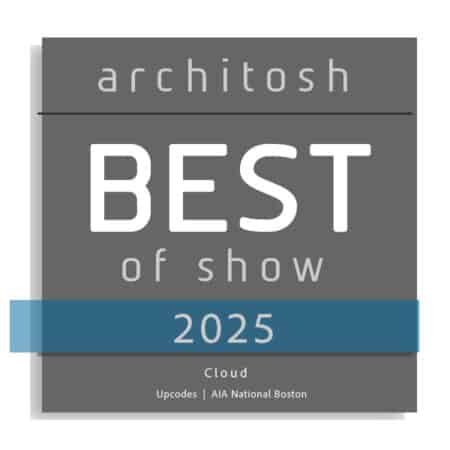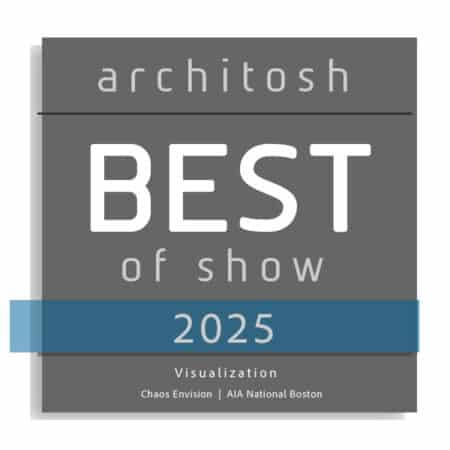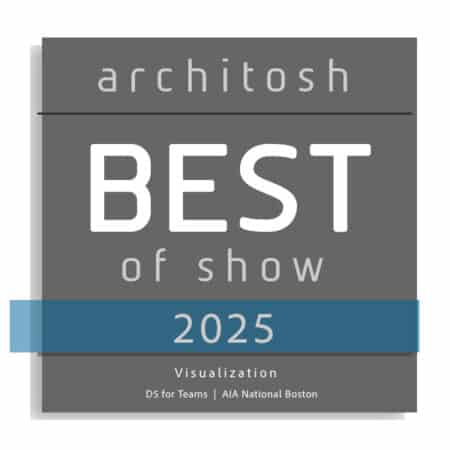BIM 2.0, AI, CLOUD, AND VISUALIZATION were all showcased to a great extent at this year’s AIA25 Boston. This year’s annual convention and expo by the American Institute of Architects (AIA) featured an array of new software solutions and brand-new companies at the show, many of which were making their debut. Chief among those was the highly anticipated Arcol, a BIM 2.0 software platform that had show attendees quite interested.
Architosh BOS
This is our 11th year judging what we saw as the ‘BEST of SHOW’ at the AIA25 Boston. The Architosh AIA BEST of SHOW honors aim to highlight and draw attention to noteworthy solutions for digital practice in architecture and the AEC/O industry as a whole. These awards — which do feature a prize — are only available to products shown on the expo floor or inside a session. Companies that create parallel events during AIA and show off their products in hotel rooms and architecture firms are not eligible for these honors and the prizes that come with them.
Honors and Prizes
Speaking of prizes, all winners of our 11th AIA BEST of SHOW honors receive digital BEST of SHOW placards for display in their marketing materials, are featured in this well-read annual special feature, and are gifted a complimentary advertising package to be used during either Q4 2025 or Q1 2026. Winners will be notified by email or phone call within 10 business days.
AIA25—Thematic Issues
Over the years, we have stepped back and written a “perspectives” feature about the honorees and the trajectory of digital technologies for architects. This year, we are doing a video session instead to be promoted on our new Architosh Official YouTube channel.
And now the honors for the best tech we saw this year at AIA25 Boston. But first, an overview of our award categories and criteria.
Award Categories and Criteria
Our award categories are designed to be broad and flexible, enabling us to honorably note a product across a range of categories if so warranted.
- Emergent Technology (emTech) Category Award — acknowledges industry potential for novel or bleeding edge technology implementations that will offer “thematic” change for practice or create convergent technology paths and drive synergistic directions for the industry.
- Innovation Category Award — acknowledges the “most promising” companies and products that are heralding innovative “new directions” in AEC software or hardware technologies, as measured by: (a) implementation quality, (b) acceleration of quality of solution, (c) quality of attack on addressing “pain points” in practice, and (d) fitting convergent technology paths and driving at synergistic directions for the industry.
- BIM Category Award — acknowledges both new or mature companies and products serving the “BIM workflow” industry transformation, touching down at any segment of the MacLeamy Curve where value gets added, as measured by: (a) implementation quality, (b) acceleration of quality of solution, (c) quality of attack on addressing “pain points” in BIM workflows, (d) adoption, extension and commitment to Open BIM philosophies so that data and toolchains are social and democratized to their fullest extent, and (e) fitting convergent technology paths and driving at synergistic directions for the industry.
- Cloud Category Award — acknowledges technology solutions (software or hardware) driving at full utilization of synergistic and maturing “cloud-to-mobile,” “mobile-to-cloud,” and “cloud-to-web” technology stacks, exhibited or seen at the AIA convention, as measured by: (a) implementation quality and novelty, (b) acceleration of quality of solution, (c) quality of attack on addressing pain-points in AEC, and (d) fitting convergent technology paths and driving at synergistic directions for the industry.
- Visualization Category Award — acknowledges the “most compelling visualization solutions” and technologies that are “transforming the architect’s workflow,” heralding new ways of seeing architecture for all stakeholders and not just clients, accelerating design optioneering, material, and light discovery, design problem solving, and design collaboration, as measured by: (a) implementation quality, (b) acceleration of quality of solution, including rendering speeds and image qualities, (c) quality of attack at addressing “pain points” in practice, and (d) fitting convergent technology paths and addressing synergist directions in the industry.
- The Economics Prize — reflecting an important shift within the architectural industry to acknowledge the extent of poor economics for architects and a newfound demand for better working conditions and pay, the Economics Prize is awarded to digital technology that shines in the direction of better economics for architects, as measured by: (a) sizeable process improvements to common industry deliverables via creative disruption (ie, Uber-ize a known process), (b) notable value disruption by a vendor via license cost comparison without “bundling,” (c) notable outsized release update delivering exceptional value increase for users, and finally (d) performance capture due to innovative, leading-edge software or hardware solutions.
Congratulations to the 2025 Architosh AIA ‘BEST of SHOW’ honorees listed below.
BEST of SHOW — EMERGENT TECHNOLOGY Category
Winner: C.Scale
C.Scale, an embodied carbon calculator, has released multiple versions of its toolset integrated into other software on the AIA show floor, including Autodesk Forma and ARCOL, as well as a stand-alone version. “Democratizing access for all projects and users as a company goal is pretty convincing,” said Pete Evans, AIA, IDSA, senior associate editor, Architosh. “And C.Scale delivers a toolset for consequential early project use that becomes more detailed as the project naturally progresses. Being able to look at wall assemblies was quite impressive to compare different building system approaches.” C.Scale has a subject matter expert-designed machine learning model that can impact whole-life carbon from proposals to design, to regulatory submission, to verifying emissions.
Criteria Notes: Both the novelty and the core technology impact potential thematic change for how practitioners can more easily address the carbon footprint of their building designs. The embedment of the C.Scale carbon engine into tools like Arcol, Forma and Graphisoft’s upcoming Aurora signal the impact and importance of C.Scale’s technology.
BEST of SHOW — INNOVATION Category
Winner: Polycam
Polycam, founded in 2021, shifted its social-media focus over the past two years toward serving the professional AEC industry. The company’s presence at the 2025 AIA Conference marked its first major engagement with the architectural community. Today, Polycam is recognized as the world’s leading 3D scanning platform, enabling users to capture and reconstruct spaces using images or video from phones or drones, integrating LiDAR, photogrammetry and impressively gaussian splat technology. “The capabilities and interoperability of Polycam make 3D scanning feel nearly ubiquitous for capturing existing conditions. It transforms a LiDAR-enabled phone into a powerful AEC tool,” said Pete Evans.
This open and scalable approach to reality capture allows for rapid project documentation and collaboration, offering transformative value to design and construction workflows. From a 3D scan, users can measure, crop, and generate clean 3D models that can intelligently identify architectural features such as furniture and openings. Polycam also produces accurate 2D plans with dimensions and supports 3D exports in multiple file formats, including USDZ, GLTF, and geo-referenced LAS. Its interoperability extends even further through optional integration with Transform Engine, allowing seamless workflow connectivity to CAD and BIM platforms.
Recently, Polycam introduced a new Scene feature, reminiscent of Matterport’s viewpoint system, but designed to enable multi-user collaboration. This feature allows integration of multiple objects into spaces or adding adjacent spaces into a unified 3D environment—opening new possibilities for accurate test fits and interactive spatial coordination using separate but compatible scans.
Criteria Notes: Not only is Polycam a promising young company it is already a dominant player in the democratization of reality capture technologies. It’s implementation quality (a), quality of attack (c) on addressing the paint point of capturing existing conditions rapidly are standout features of the solution, as well as convergent technologies (d) in its Vision Pro compatibilities and more.
Winner: TwinMaster
TwinMaster is a new AI-powered digital twins platform created for the AEC industry that focuses on bridging the gap between design and real-world performance by tapping the power of intelligent AI technologies. “What’s really innovative with TwinMaster is the development of its ‘Arch-e’ multi-agent AI copilot,” says Anthony Frausto-Robledo, AIA, Editor-in-Chief, Architosh. “Users can leverage natural language inquiries just like in ChatGPT to interact with 3D BIM models across a range of simulation and optimization topics. The results are both graphic, 3D-based and highly engaging and the system can generate new 3D building models just from prompts.”
The ‘Arch-e’ AI copilot supports workflows that help architects build and model, analyze, decide and explore their designs, using site-specific intelligence. TwinMaster features multi domain-specific AI agents that can intelligently inform on questions ranging from sustainability, cost estimation, carbon emissions, daylight analysis, local zoning compliance and more. TwinMaster can ingest any standard 3D (BIM) model including Revit, Rhino, SketchUp and others.
Criteria Notes: TwinMaster was quite breathtaking to witness at their AIA25 booth and the company is led by a very impressive team of technology and business leaders. We have to acknowledge that this is a very promising company and solution that we look forward to actually testing out in a product review once it leaves beta later this year. The implementation quality (a) of the solution looks excellent, and the approach to using text prompts and multi- AI agents to address multi-AEC domain pain points in practice (c) appears ahead of anything else in the industry.
BEST of SHOW — BIM Category
Winner: Arcol
Arcol largely made its debut at AIA25 in Boston, and their booth was constantly well-attended,” says Anthony Frausto-Robledo, Editor-in-Chief of Architosh. “The new pre-design or design intelligence BIM 2.0 software does things that the traditional BIM platforms cannot. Chief among these is the rapid conceptual modeling with fully synced design data, even basic or conceptual cost data,” adds Frausto-Robledo. “Arcol is another BIM 2.0 tool that supports live multi-user team integration, but what sets Arcol truly apart is its advanced modeling capabilities, including lofts, booleans, and more.”
Arcol version 1 includes live-synced Archol boards, which are used for presentations, as well as “generative fills” where the software can generate optimal building layouts. “What was also impressive about Arcol was its intuitive and attractive user interface and its speed,” adds Frausto-Robledo. “We saw impressively large urban scenes move very quickly for a 3D tool in the web browser.”
Criteria Notes: Arcol is attacking the same pain-points (c) that forerunner Autodesk Forma has addressed—the primary one being traditional BIM authoring tools’ poor ability to address intelligent, computation-based pre-design, site test-fitting, and detailed analysis-driven workflows. We applaud its implementation quality (a) at its debut release, especially its appealing user-interface and simplified and early costing controls. Like Forma, it too includes the concepts of presentation boards.
Winner: Revizto
Revizto had a very good presence at AIA25 Boston though many American architects are unaware of how powerful and beneficial the Revizto cloud-based BIM collaboration platform actually is due. “Revizto is the ultimate BIM “single-source of truth” (SSoT) collaboration and coordination platform,” says Anthony Frausto-Robledo, AIA, Editor-in-Chief, Architosh. “With more than 7 million lines of code built on top of the Unity game engine, Revizto brilliantly leverages Unity and can handle the world’s largest BIM projects—projects so large that they crash every other BIM model viewing platform with the exception of Dalux.
Able to ingest BIM and 3D models from nearly every single BIM authoring platform across architecture and engineering—plus 3D design software like SketchUp and Rhino—Revizto occupies a rare and important place in the BIM world,” adds Frausto-Robledo, AIA. “What makes Revizto stand out is that it solely focuses on BIM and design model coordination, BIM collaboration, and clash detection and issue management. This isn’t a common data environment (CDE) with an inspiring BIM model viewer app, Revizto does integrations with CDEs, not pretends to be one. While CDEs like Asite, Aconex, ACC and Procore can only dream of the power and capability of Revizto’s industrial-strength federated BIM collaboration environment.”
Criteria Notes: Revizto is addressing the real needs of BIM collaboration, including the fact that no one BIM platform will ever meet the needs of all building and project types and thus supports and encourages an Open BIM philosophy where best-of-breed tools can author and synch to Revizto and all stakeholders can coordinate, collaboration, find clashes and issues and manage the entire multi-disciplinary AEC design process from one platform agnostic environment. Revizto addresses (A-D) aspects of our BIM judging category and it should be especially lauded for its ability to synch up 2D data with 3D model data in a unified view that is quite compelling and useful.
Winner: MEP Designer
Graphisoft introduced the new MEP Designer, which is fully integrated into Archicad. There is also a separate product, MEP Designer for Engineers, that will also be available soon. The main goal of these new MEP tools is to effectively incorporate MEP design considerations into early architectural planning, allowing architects and engineers to optimize building performance,” says Frausto-Robledo. “This goes beyond the old “MEP Modeler,” the new MEP Designer includes automated system design and built-in energy analysis.
Criteria Notes: MEP Designer represents parts of Graphisoft’s greater push into AI and data-centric design, assisting architects in streamlining MEP to architecture design and coordination and leveraging more intelligent multi-disciplinary workflows. It therefore primarily accelerates parts of the BIM workflow (b) while offering the Archicad user a high-quality (a) implementation for MEP design with energy analysis.
Winner: SketchUp 2025
SketchUp 2025 significantly expands its cloud-based capabilities while preserving the intuitive ease-of-use that has long defined the platform and advancing on better BIM workflow integrations. Key updates include major rendering enhancements such as real-time Photorealistic Materials supporting seamless custom materials generated by users or AI, and advanced environmental Image-Based Lighting (IBL). These features build on the Ambient Occlusion tools introduced in 2024, further elevating the visual quality to higher standards.
“Collaboration is also enhanced, with an intuitive interface mirroring the simplicity of Google Docs,” adds Pete Evans, AIA, “enabling easy tagging, commenting, and content sharing within a shared model environment. The update offers robust interoperability with industry-leading formats, including IFC4, USDZ, and GLB, for both import and export,” adds Evans, “thereby further enhancing the platform’s integration with the powerful Trimble Connect ecosystem as well as other CDE and BIM collaboration tools, like fellow-winner Revizto.”
Additionally, 3D Warehouse now includes support for these new visualization features and integrates AI-driven functionality. SketchUp 2025 continues to evolve into a versatile design toolset—simple enough for beginners, yet powerful enough for advanced users with seamless workflows into V-Ray and beyond.
Criteria Notes: SketchUp 2025’s IFC import updates are a major solver of existing BIM workflow pain-points, attacking longstanding issues (c) in the industry where many contractors and sub-contractors utilize SketchUp, in addition to architects. At the same time SketchUp further advances collaboration BIM workflows with interoperability with native Revit file import, plus you can now model straight on point clouds to detail existing building scans. (e)
BEST of SHOW — CLOUD Category
Winner: Upcodes
Web-based UpCodes released their Copilot AI-powered research assistant over the past winter with the ability to solve code compliance across multiple codes and building assembly types, and with respect to local jurisdiction. “The complexity of this task only broadens the value Upcodes brings by drastically democratizing this aspect of the design phase,” Pete Evans noted. “Upcodes Copilot provides an interface to design in compliance with instant inquiries about codes, assemblies, compare related sections, read explanations, perform calculations, and summarize for a better project understanding.”
Upcodes has also introduced code-compliant product libraries to meet sustainability and assembly requirements with over 270,000 products and 3,000 manufacturers. And Diagrams is an additional compelling high-resolution visual library with powerful filtering for code types, topics and phases. In short, Upcodes is a product the AEC industry has long dreamed of having.
Criteria Notes: AI tools like ChatGPT were quickly utilized by AEC professionals to assist in building code research. Upcodes is leveraging this obvious pairing of disruptive AI technologies, cloud technology, and large bodies of public legal text in the AEC industry to address age-old pain-points in the industry. (c + d) What Upcodes also does beautifully is communicate code requirements in clear diagrams and its Copilot can surface diagrams that relate to what the user is researching. (a)
BEST of SHOW — VISUALIZATION Category
Winner: Chaos Envision
Chaos Envision largely levels up many of the technologies and concepts in Chaos’ popular Enscape real-time visualization solution, but it goes far beyond that. Shown at AIA25 to show attendees, Envision is far more than rendering; it’s storytelling, communication and thus collaboration. “What makes Chaos Envision enticing to architects is the superior visual quality paired with an approachable real-time immersive rendering platform,” says Anthony Frausto-Robledo, AIA. “At first blush Envision combines V-Ray-like photorealism with the ease-of-use of Enscape, facilitating the ability to create variation-based animation, show animated people and transportation systems, and you can animate components of the buildings themselves.”
Ingesting CAD and BIM models from a wide variety of resources, Chaos Envision supports robust inter-app workflows including taking scenes created in Enscape and bringing them into Envision to create cinematic quality animations. Cameras can get assigned to paths that are easy to create in themselves and anything the Chaos Anima engine can place on a path (like people) gain not just movement but AI-based behaviors, as in the case with people and crowds. While the step-up in photorealism is not quite equal to V-Ray, it is very close and a noticeable improvement to Enscape imagery.
Criteria Notes: Chaos’ implementation quality on Envision is very good, scaling up scene complexity while keeping the user-interface (UI) approachable. (a) All architects dream of bringing their designs to life in sophisticated cinematic visuals but that ability has largely required complex DCC tools used by specialists and visualization agencies. (c) Envision continues the democratization process of fulfilling this dream architects have, lowering the accessibility point (c), leveraging AI-based technologies from Anima (d) and generally providing a fuller spectrum of visualization options for AEC professionals.
Winner: D5 for Teams
Already a standout visualization tool at a very high level of real-time rendering, D5 adds NVidia DLSS 4 Multi-frame generation and ray reconstruction in 2025 for even smoother and faster rendering. A new City Generator with OpenStreetMap and Shapefile integration have also been added with ‘AI Inpainting’ for partial modification of renderings. “The 2025 release of D5 for Teams really stood out with its extensive collaboration capabilities with team asset libraries and cloud workspaces directly from different softwares. This Visualization Collaborative Platform (called a “VCP”) approaches a Common Data Environment (CDE) utility with creative design applications directly, which is novel and impressive,” noted Evans.
This VCP allows collaborators to stay in their native formats (currently supported are SketchUp, 3ds Max, Revit, Rhino, Archicad, Blender, C4D, Vectorworks) and in a common cloud space at the same time. This also opens D5 to designers on Macs, saving their work to the VCP D5 for Teams on the cloud for further work with their team.
Criteria Notes: D5’s concept of a ‘visualization collaborative platform’ (VCP) unfolds a trend in the larger industry where cloud-connected tools foster newfound abilities to work together. (c-d) This takes the shape of multi-user editing (MUE) which also existed in other BEST of SHOW winners this year like BIM tool Arcol. The concept of the VCP suggests other next-steps for D5 for Teams but overall D5 for Teams begin to alter and transform the architect’s workflow and thinking about workflows. (c-d)
BEST of SHOW — The Economics Prize
This year we are again not offering this award category. However, if the new AEC software company bimbeats were at the AIA25 Boston show, we would have honored it with this Economic Prize.

